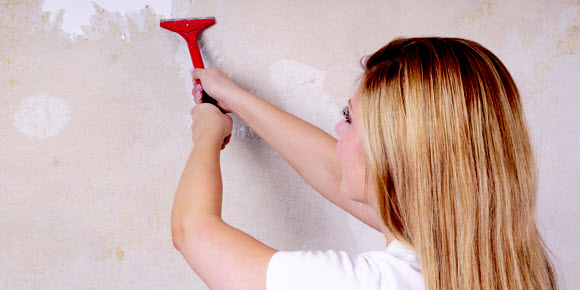by Bill and Kevin Burnett
Question: I used hot water to remove old wallpaper in a bedroom, which caused “bubbling” or blistering of the drywall. Apparently, I used too much moisture and seem to have lifted the texture on the drywall. Do I scrape it and apply new texture and, if so, what is the best method? It is affecting only parts of two walls in the bedroom and would not involve the whole walls, just areas. What is the best method to go about this?
Answer: Making holes in walls while removing wallpaper is part of the job. Getting the wallpaper off is only the beginning, as you’re about to find out.
You’re right; wetting the walls caused the bubbling. The paper “skin” of the drywall became saturated and released from the gypsum core. The fix will take some work, but it’s relatively simple.
Before even thinking about tackling the bubbles, make sure the wallpaper paste residue is off the walls. A good sponge-washing with TSP (trisodium phosphate) will take care of this. For stubborn particles use a Scotch-Brite pad. Mix the TSP with water according to package directions. Use a sponge to wash the walls and remove the paste residue. Once the paste is all off, rinse the wall with clean water.
Scrape off the bubbles with a four-inch drywall knife. Try not to gouge the walls, but make sure to get all the loose material off. Then it’s time to patch.
We like to use a fast-setting joint compound like Durabond 45. It allows you to work at a steady pace but doesn’t hold up progress while waiting for the mud to dry.
Durabond 45 is a powder that is mixed with water and sets hard in about 45 minutes. Mix only enough material that you can comfortably apply in 15 to 20 minutes. Any more time and the mud starts to harden and is tough to work.
Patch the holes using a four-inch drywall knife. Smooth it as best you can, but don't work it too much. Sand the patches smooth between coats with 150-grit sandpaper. It will probably take a couple of coats to complete the job. With the wall sanded smooth, it’s ready for the finish of your choice: smooth wall, texture or more wallpaper.
Question: Your column about removing vintage wallpaper was great — very detailed and specific. I have a different wallpaper question. One of our bathrooms has painted walls (latex enamel) with quite a bit of texture. I would like to wallpaper that room using striped paper and I think that would look messy over textured walls. What should I do?
Answer: Do not paper over the texture. The walls will look like they have a bad case of acne. The answer is to make the bumpy walls flat by applying a skim coat of joint compound over the entire wall. The good news is that it’s definitely a do-it-yourself job and not that tough to do.
It brings up a blast from our past. When Mom was newly widowed, she moved from the family home to a condo. We’ve mentioned from time to time that our dad was a master plasterer. All the walls in that house were smooth plaster of the highest quality. Many of the walls were wallpapered.
Mom wanted wallpaper on the textured walls in her bedroom. She hired a local painting contractor to come in and skim coat over the texture to smooth out the walls. He then primed the wall, sized it and wallpapered. We didn’t care much for her paper selection, but he did a good job. It looked good and it lasted.
The first step is to lightly sand the wall to cut down the gloss of the paint and provide some “tooth” to the surface. Skim coating is pretty easy. Use regular premixed joint compound. Thin it with water until it’s the consistency of honey. It will spread smoothly and easily.
Apply the joint compound over the entire wall with a broad knife — eight inches or more. Let it dry and sand it with 150-grit sandpaper. Repeat the process.
It will probably take three coats of mud to get the wall perfectly smooth and ready for primer and wallpaper.
— Inman News.



